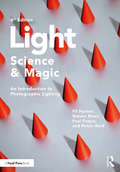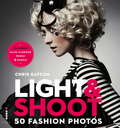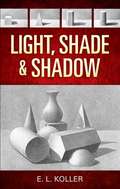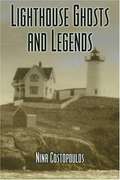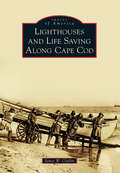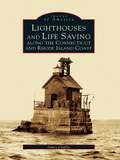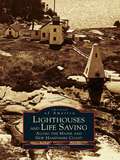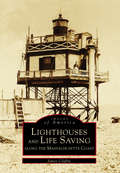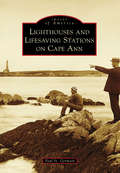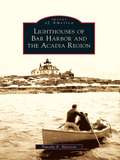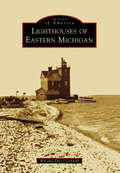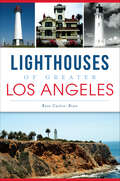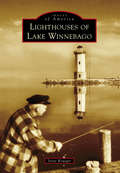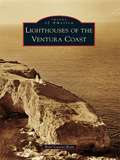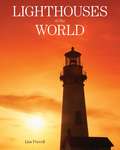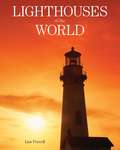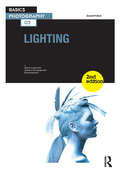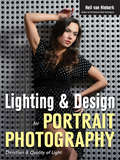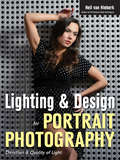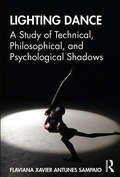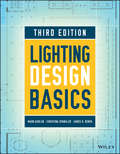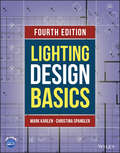- Table View
- List View
Light — Science & Magic: An Introduction to Photographic Lighting
by Steven Biver Fil Hunter Paul Fuqua Robin ReidPhotographic lighting is a topic that will never go out of style, no matter how sophisticated cameras and other technology get. Even with the most high-tech gear, photographers still need to put a lot of thought and vision into lighting their photographs in order to get great results. Mastering this key skill has the power to dramatically and quickly improve your photographs as well as your efficiency. Light—Science & Magic provides you with a comprehensive theory of the nature and principles of light, with examples and instructions for practical application. Featuring photographs, diagrams, and step-by-step instructions, this book speaks to photographers of varying levels. It provides invaluable information on how to light the most difficult subjects, such as surfaces, metal, glass, liquids, extremes (black-on-black and white-on-white), and portraits. This new edition includes: • Expanded chapters on portraiture and lighting equipment • Chapters on necessary equipment when working on location versus in the studio • An updated appendix of reliable photo gear sources • Over 100 new photographs and informational sidebars • Updated information about advances in flash equipment, LED panels, and fluorescent lights Lighting styles will evolve, but the science of light will always remain the same. Once photographers understand the basic physics of lighting (without having to become physicists), they can apply that knowledge to a broad range of photographic styles.
Light&Shoot: 50 Fashion Photos
by Chris GatcumHave you ever wondered what it really takes to be a fashion photographer? Want to learn what the pros do in the field on a daily basis to create compelling, artistic, iconic fashion imagery? <P><P>Then this is the book for you With a focus on lighting, Light and Shoot takes 50 truly amazing fashion photos and tells the budding fashion photographer how each was created. First is the equipment "must-haves. " Next are lessons on how to integrate make-up and lighting. From there, you will learn how to shoot for the three main outlets: catalogue, editorial, or advertising. From beautiful photos and lighting diagrams to the photographer's thoughts behind the photos, to a snapshot that shows what camera, ISO, shutter speed etc. were used, this book will give you the tools you need to light and shoot your own fashion photos.
Light, Shade and Shadow (Dover Art Instruction Ser.)
by E. L. KollerDuring the first half of the twentieth century, E. L. Koller wrote a series of art instruction books for home study, designed to simplify various techniques for beginning artists — and help established artists polish their craft. The books are as relevant — and the information as essential — to artists today as it was then. A classic in this series, Light, Shade and Shadow, shows how the study of light is a necessary foundation for creating an appealing work of art. Even the most beautiful drawing can appear flat without shading. But with this expert guide, every artist can learn how to use shadow to add visual dimension and drama to their work, and to master techniques such as highlighting and gradation. Beginning with the basics — casting light on simple geometric shapes — and progressing to the human figure, these step-by-step techniques, illustrations, and exercises can show artists of all abilities how to achieve a new level of depth in their work.
Lighthouse Ghosts and Legends
by Nina CostopoulosFrom the Book jacket: There is something mystical and romantic about the soft glow of a lighthouse spinning out across the ocean. Beyond that protective light, however, many of America's lighthouses are plagued by a dark history of vicious storms, violent shipwrecks, and, in some cases, even murder. Today, the ghosts of the past still linger in the lonely corridors of many American lighthouses, making their history known. In 1899, Muriel, the sweet-tempered daughter of a sea captain disappeared from the Yaquina Bay Lighthouse in Newport, Oregon, leaving behind only a small pool of blood and her white handkerchief. Today, she is seen on dark stormy nights and has been known to bolt the lighthouse door, allowing no one in-not even those with a key. The sounds of former Captain William Robinson's footsteps and the methodical tap of his cane can still be heard walking the corridors of the White River Light in Whitehall, Michigan. Ernie, the ghost of the former keeper of Ledge Light, near New London, Connecticut, polishes brass, swabs the decks, leaves tools about the lighthouse, and rearranges books on bookshelves. Following on the heels of Crane Hill's bestselling Lighthouse Ghosts, Lighthouse Ghosts and Legends brings fans of watery hauntings more of their favorite lore. Author Costopoulos weaves eighteen tales of mystery surrounding some of America's best known beacons, including St. Simon's Island, Alcatraz Island Light, Owl's Head Lighthouse, Hendricks Head Light Station, and more. Covering the extent of coastal America and the Great Lakes, Lighthouse Ghosts and Legends runs the gamut of sprites, spirits, mysteries, miracles, and madness.
Lighthouses and Life Saving Along Cape Cod
by James W. ClaflinFor centuries, heroic men and women have guarded the treacherous yet beloved Cape Cod coastlines. From Provincetown to Chatham, Sandwich to Cuttyhunk, and many towns in between, residents have relied on the Atlantic for employment and nourishment. But Cape Cod has always been plagued with a shifting coastline that consistently defies mariners' efforts to pass through Massachusetts waters. In 1792, as shipping increased, mariners petitioned for a sorely needed lighthouse. It was not until 1797 that the first lighthouse on Cape Cod was built at the Highlands in North Truro. More lights and rescue stations would follow as the seas claimed their toll. Many lightship stations were also established from Chatham through Nantucket Sound to mark the constantly changing sandbars submerged offshore--more than in any other spot along the US coastline. Today, as sea levels change and sands continue to shift, some of these historic stations have been lost or moved, while still others are preserved only in such photographs as these.
Lighthouses and Life Saving Along the Connecticut and Rhode Island Coast (Images of America)
by James ClaflinLighthouses and Life Saving along the Connecticut and Rhode Island Coast is the third in a series of titles offering a unique tribute to the men and women who protected the mariners as they traveled along New England's rocky coastline. Thousands of vessels faced the dangers of the rugged sea which caused hundreds of shipwrecks off the coast with devastating losses. Author James Claflin combines a thoroughly descriptive text with this diverse collection of over two hundred vintage images, from private as well as museum collections, to create an illustrated history of an area strongly reliant on its coastal trade. The U.S. Light-House Establishment and the U.S. Life-Saving Service, which later merged to become the U.S. Coast Guard, assumed the responsibility of lighting and protecting the coasts. Inside, you will see the lighthouse keeper at Bullock's Point Light as he surveys the damage from the Hurricane of 1938, witness the life savers at Block Island's Sandy Point Station where first word of the wreck of the steamer Larchmont was received, and experience life on an offshore lightship. The book guides you through the days of the life savers-the work they performed, their rescues, and the evolution of their architecture through the years.
Lighthouses and Life Saving along the Maine and New Hampshire Coast
by James ClaflinLighthouses and Life Saving along the Maine and New Hampshire Coast is a unique tribute to the men and women who protected mariners as they traveled along New England's rocky coastline. With thousands of vessels plying the dangerous waters, the chance of a shipping disaster was always great. Hundreds of shipwrecks did indeed occur off the coast with startling losses. Through descriptive text and a variety of vintage images from private as well as museum collections, we get a rare glimpse into the lives of the dedicated government men and women.Author James Claflin combines an extensively researched text with this exquisite collection of previously unpublished images to tell the story of an area heavily dependent on its coastal commerce. The task of lighting and protecting the coasts was taken on by the U.S. Light-House Establishment and the U.S. Life-Saving Service, later merged to become the U.S. Coast Guard. Within these pages, see the Boon Island Lighthouse keeper, his family alongside, as he proudly poses in his uniform; life savers at Hunniwells Beach station as they pull through a blinding snowstorm to rescue the crew of a stranded schooner; and the way of life on an offshore lightship. Lighthouses and Life Saving along the Maine and New Hampshire Coast is a visual journey into our nation's maritime history.
Lighthouses and Life Saving along the Massachusetts Coast (Images of America)
by James ClaflinLighthouses and Life Saving along the Massachusetts Coast is a unique tribute to the men and women who protected mariners from shipping disasters. With a variety of vintage images from private as well as museum collections, this rare glimpse into the lives of the dedicated workers who protected thousands of vessels plying the dangerous waters of Massachusetts Bay and Nantucket Sound is a visual journey to an earlier era in our nation's history. Author James Claflin combines an extensively researched text with this exquisite collection of many previously unpublished images to tell the story of a state dependent upon its coastal commerce. From Cape Ann to New Bedford, residents of Massachusetts have relied heavily on the sea for employment, trade, and nourishment. The task of lighting and protecting the coasts was taken on by the U.S. Lighthouse Establishment and the U.S. Life-Saving Service. Within these pages, see the Cape Ann lighthouse keeper proudly posed in his uniform, the Cape Cod life savers launching their surf-boat through the breakers toward the shipwreck, and the Boston Bay lighthouse keeper's family returning by skiff from their brief excursion to town.
Lighthouses and Lifesaving Stations on Cape Ann (Images of America)
by Paul St. GermainThe maritime history of Cape Ann, on the northern coast of Massachusetts, is filled with stories of heroism, adventure, and human endeavor. The lighthouses and lifesaving stations surrounding Cape Ann since the late 18th century have served to protect and safeguard the area's mariners and major industries. Fishing, shipbuilding, and granite quarrying businesses all flourished under their watchful eyes. They provided artists with spectacular subject matter and attracted tourists from around the world to visit them. This book highlights the heroism and dedication of the lighthouse keepers and lifesaving surfmen who served. Cape Ann is famous for being the home of America's oldest seaport in Gloucester and America's most painted building, Motif No. 1, in Rockport.
Lighthouses of Bar Harbor and the Acadia Region
by Timothy E. HarrisonWith the exception of Mount Desert Island's Bass Harbor Head Lighthouse, the lighthouses of Bar Harbor and the Acadia region are among the most remote and lesser-known lighthouses of Maine. As the vessel traffic changed in these areas in the early 1900s, some of these lighthouses were sold into private ownership while others became less important as aids to navigation. Since the structures were located on remote islands or in a highly restricted military installation, the photographs and historical firsthand memories of most of these lighthouses have remained elusive and seemingly lost in the dusty pages of time. Through vintage photographs, Lighthouses of Bar Harbor and the Acadia Region uncovers the history of these structures that kept watch over Maine's rocky coast.
Lighthouses of Eastern Michigan
by Pat O'Connell Wil O'ConnellFrom the Straits of Mackinac to the Detroit River, Images of America: Lighthouses of Eastern Michigan reveals intriguing stories of lighthouses and the people who depended on them. Readers will enjoy discovering what happened when a large ship fell 20 feet over one of the Soo Locks and the captain commented, "Good-bye Old World," as well as of a persistent ghost that caused havoc with the Coast Guard. Which lighthouse was a construction miracle in 1874? And whatever happened to the lost lighthouses of the Detroit River? A collection of the mysteries, storms, fires, and heroics surrounding the lighthouses of eastern Michigan are waiting within.
Lighthouses of Greater Los Angeles (Landmarks)
by Rose Castro-BranDespite news of shipwrecks along California's dangerous coastline, a burgeoning maritime trade came to what would become the ports of Los Angeles and Long Beach. The shipping complex became the nation's busiest, in part because of the bright navigation lights that enabled reliable access for early vessels. In 1874, sister lighthouses Point Fermin and Point Hueneme were lit on the same day, followed by the Los Angeles Harbor Lighthouse in 1913. Nicknamed the "Hollywood Lighthouse" for its frequent use in movies, in 1926, Point Vicente was established to light the Palos Verdes Peninsula. Today, they are joined by the Anacapa Island Light Station, Long Beach Light and the private aid to navigation, Lions Lighthouse for Sight. Together with the U.S. Coast Guard, these historic beacons continue to illuminate and protect the coast of Greater Los Angeles. Join author Rose Castro-Bran as she explores their storied history.
Lighthouses of Lake Winnebago (Images of America)
by Steve KruegerLake Winnebago has a rich history as a major settlement area in the Midwest, and a significant part of its times gone by involved water transportation for both commerce and passengers. Throughout its history, the 137,700-acre lake has been home to six current lighthouses, two navigation lanterns that have long disappeared from the landscape, and one that was scheduled to be built but never came to fruition. History has forgotten a few, but Lighthouses of Lake Winnebago will take you on a trip around the largest lake within Wisconsin’s borders and show you the familiar, while introducing you to the forgotten.
Lighthouses of New Hampshire (Images of America)
by Jeremy D'EntremontNew Hampshire's seacoast may be just 18 miles long, but what it lacks in length, it makes up for with centuries of fascinating maritime history. Portsmouth developed along the banks of the Piscataqua River to become the state's colonial capital and a center of trade and shipbuilding. Portsmouth Harbor's 1771 lighthouse was the first lighthouse established in the American colonies north of Boston. A few miles offshore, Native Americans were fishing and hunting at the archipelago known as the Isles of Shoals for centuries before the islands were developed by European fishermen and settlers in the 1600s, and a lighthouse was established at the southernmost island in 1821. Inland, three wooden lighthouses were built on Lake Sunapee in the late 1800s to guide steamships full of vacationers to their destinations around the lake. All of these locations have stories to tell of dedicated keepers and their families, shipwrecks, rescues, and much more.
Lighthouses of the Ventura Coast
by Rose Castro-BranThe Ventura County coast has been illuminated for more than a century by three distinctive lighthouses, united in their mission of warning mariners of coastal hazards and guiding ships to safe passage. Port Hueneme's original 1874 Victorian Stick Style lighthouse stood sentry until it was replaced in 1940 by the still-standing art moderne structure, which guards the only deepwater port on the California coast between San Francisco and San Pedro. The Anacapa Island Light, a cylindrical brick structure in the Channel Islands lit in 1932, was the last new lighthouse on the West Coast. Ventura, originally dubbed San Buenaventura by Fr. Junipero Serra in 1782, extends its "good fortune" to the steamers, warships, tankers, and other craft guided to safety by these navigation beacons.
Lighthouses of the World
by Lisa PurcellFrom ancient times until the present, lighthouses have symbolized safety, homecoming, and the seafaring way of life. Lighthouses of the World provides gorgeous full-color photos showcasing lighthouses from around the world. From the Barnegat Lighthouse on Long Beach Island, to the ancient Kõpu Lighthouse in Estonia (first constructed in 1531), Lighthouses of the World traverses continents in order to provide stunning color photography and illustration showing the many different lighthouses that man has constructed over the centuries.
Lighthouses of the World: 130 World Wonders Pictured Inside
by Lisa PurcellReaders say it best: "fascinating book" with "beautiful photos" and "information regarding all kinds of light houses"From ancient times until the present, lighthouses have symbolized safety, homecoming, and the seafaring way of life. Lighthouses of the World provides gorgeous full-color photos showcasing lighthouses from around the world. From the Barnegat Lighthouse on Long Beach Island, to the ancient Kõpu Lighthouse in Estonia (first constructed in 1531), Lighthouses of the World traverses continents in order to provide stunning color photography and illustration showing the many different lighthouses that man has constructed over the centuries.
Lighting
by David PräkelUnderstanding light is fundamental to good photography. How any image is lit will change how the viewer sees and interprets the content. The second edition of Lighting teaches the theory and background of how light works, the different types of light and the rules it obeys. The book gives guidance on how to measure, control and use light for the best photographic exposure. With new images and case studies, this edition encourages a bolder and more innovative approach to the use of light in photography.
Lighting & Design for Portrait Photography
by Neil Van NiekerkSome photographers make portraits that we can’t take our eyes off of. These images create mood, evoke emotion, and pique our curiosity. They have that certain something that other portraits seem to lack. These rare images are memorable-the kind of shots that clients want and photographers strive to emulate. These portraits are technically precise and have style. Neil van Niekerk is a big name in the portrait and wedding photography industry. His masterful photographs get a reaction, and he’s devoted to helping others create compelling portraits for their clients. In this book, van Niekerk shows readers strategies for creating a wide range of portrait looks (romantic, fun, sweet, dramatic, glamorous, or moody) in lackluster, middle-of-nowhere locales, small home studios, big expanses, and even on rooftops. Starting with traditional lighting and posing strategies and moving through "spicier” varieties, he shows readers how integrating specialized lighting (rim lighting, backlighting, flare, and low-key lighting-using natural light and artificial sources) and compositional approaches (shallow depth of field, lens compression, and unorthodox perspectives) into their creative approach can allow them to take full creative control over their portrait-taking process so that they’re able to deliver incredible shots of their clients in any photographic conditions.
Lighting & Design for Portrait Photography
by Neil Van NiekerkSome photographers make portraits that we can't take our eyes off of. These images create mood, evoke emotion, and pique our curiosity. They have that certain something that other portraits seem to lack. These rare images are memorable-the kind of shots that clients want and photographers strive to emulate. These portraits are technically precise and have style.Neil van Niekerk is a big name in the portrait and wedding photography industry. His masterful photographs get a reaction, and he's devoted to helping others create compelling portraits for their clients. In this book, van Niekerk shows readers strategies for creating a wide range of portrait looks (romantic, fun, sweet, dramatic, glamorous, or moody) in lackluster, middle-of-nowhere locales, small home studios, big expanses, and even on rooftops. Starting with traditional lighting and posing strategies and moving through "spicier" varieties, he shows readers how integrating specialized lighting (rim lighting, backlighting, flare, and low-key lighting-using natural light and artificial sources) and compositional approaches (shallow depth of field, lens compression, and unorthodox perspectives) into their creative approach can allow them to take full creative control over their portrait-taking process so that they're able to deliver incredible shots of their clients in any photographic conditions.
Lighting Dance: A Study of Technical, Philosophical, and Psychological Shadows
by Flaviana Xavier SampaioLighting Dance pioneers the discussion of the ability of lighting design to foreground shadow in dance performances. Through a series of experiments integrating light, shadow, and improvised dance movement, it highlights and analyses what it advances as an innovative expression of shadow in dance as an alternative to more conventional approaches to lighting design. Different art forms, such as painting, film, and dance pieces from Loie Fuller, the Russell Maliphant Dance Company, Elevenplay, Pilobolus, and the Tao Dance Theater served to inspire and contextualise the study. From lighting to psychology, from reviews to academic books, shadows are examined as a symbolic and manipulative entity. The book also presents the dance solo Sombreiro, which was created to echo the experiments with light, shadow, and movement aligned to an interpretation of cultural shadow (Jung 1954, in Samuels, Shorter, and Plaut 1986; Casement 2006; Ramos 2004; Stein 2004; and others). The historical development of lighting within dance practices is also outlined, providing a valuable resource for lighting designers, dance practitioners, and theatre goers interested in the visuality of dance performances.
Lighting Design Basics
by Mark Karlen James R. Benya Christina SpanglerThe essential book of lighting for professional designers, now updated and revisedProviding the fundamental information new designers need to succeed in a concise, highly visual format, the Second Edition of Lighting Design Basics presents realistic goals that can be used as a guide to create simple yet impressive lighting designs and when collaborating with professional designers on more complex projects.Drawing on real-world case studies-- from kitchens to doctors' offices--the book is packed with attractive, helpful illustrations, making it an invaluable resource for students, as well as interior designers and architects studying for professional licensing exams.Authored by leading lighting designers with decades of experience Offers straightforward coverage of lighting concepts and techniques Contains design scenarios for more than twenty different types of spaces Lighting is a basic, yet difficult-to-master element of interior design. Lightning Design Basics changes that, putting the power to create in the hands of the designer.
Lighting Design Basics
by Mark Karlen James R. Benya Christina SpanglerA visual, real-world guide to professional lighting design Lighting Design Basics is the essential guide to this basic, but difficult-to-master aspect of interior design. Offering fundamental concepts and prescriptive techniques in a highly visual format, this book provides clear, practical guidance on utilizing the latest in lighting techniques and technology to showcase a space without sacrificing utility. Covering more than 25 different design scenarios with in-depth rationale for proposed solutions, this book provides insightful distribution diagrams, floor plans, and details for lighting installation and construction. Real-world case studies illustrate lighting design in residential, commercial, healthcare, education, and hospitality settings, and skill-building exercises offer practice for real-world projects as well as NCIDQ and NCARB exam preparation. This new third edition includes new instructor support materials, coverage of computer calculation software, and in-depth discussion on the latest in LED lighting. Lighting is changing, both in the technology itself, and in the way a designer must approach it. This book provides immersive instruction through real-world settings, and practical guidance suited for immediate application in everyday projects. Get up-to-date on the latest methods and technology for lighting design Examine more than 25 design scenarios for different types of spaces Complete exercises to hone your skills or prepare for the NCIDQ or NCARB Create simple lighting designs and collaborate with architects on complex projects Lighting can make or break a space. Improper lighting lends a space an uncomfortable feel, can induce headaches or eyestrain, and can even be hazardous—but thoughtfully designed and executed lighting adds that extra element so often missing from typical spaces. Lighting Design Basics shows you how to elevate any space through the fundamental tools and concepts of professional lighting design.
Lighting Design Basics
by Mark Karlen Christina SpanglerLIGHTING DESIGN BASICS AN AUTHORITATIVE INTRODUCTION TO PROFESSIONAL LIGHTING DESIGN FOR ARCHITECTS, INTERIOR DESIGNERS, AND ENGINEERS Lighting is an essential component of any designed space, yet it is one of the most difficult right. Lighting Design Basics, 4th Edition provides a fundamental grounding in architectural lighting concepts, processes, and techniques that every student must master. The book offers a carefuly balanced combination of design and technology instruction and provides a great deal of graphic information, complete with plan, section, and three-dimensional drawings. The authors examine over 25 different design scenarios with in-depth rationales for proposed solutions, insightful distribution diagrams, floor plans, and details for lighting installation and construction. Immersive instruction on real-world settings accompanies practical guidance suitable for immediate application in everyday projects. Lighting can make or break any space, and design choices impact the cost and comfort of the building over the long term. <P><P>Lighting Design Basics provides a critical foundation and prescriptive techniques to help future architects and interior designers make smart design choices. This new edition provides readers with: A new chapter, entitled Light and Health, covering the physiological aspects of lighting design Updated LED technical content with coverage of light sources, luminaires, controls, quantity and quality of light, color rendition, and calculation software tutorials Explorations of industry codes and additional material on sustainable practices Thorough discussions of lighting in residences, workspaces, educational facilities, healthcare spaces, retail stores, and hospitality environments The basic skills required to become competent in the field, and prepare for the NCIDQ and NCARB exams Designed for undergraduate students in architecture and interior design, the latest edition of Lighting Design Basics is also valuable for working professionals in both fields who want to refresh their skills in lighting design and/or lighting technology
Lighting Design Basics
by Mark Karlen James BenyaLighting is a basic, yet difficult-to-master, element of interior design, and Lighting Design Basics provides the information you need in a concise, highly visual format. Two leading designers, both with decades of experience, offer straightforward coverage of concepts and techniques, and present realistic goals you can use as guides to creating simple, typical lighting designs and when collaborating with professional designers on more complex projects. Design scenarios for more than twenty different spaces illustrate real-world case studies for illuminating residential and commercial spaces, from kitchens to doctors' offices. Each scenario includes an in-depth rationale for the proposed solution, insightful lighting distribution diagrams, floor plans, and details for lighting installation and construction. In addition, exercises allow you to develop lighting design skills in preparation for working on actual projects, as well as the NCIDQ and NCARB exams. Packed with informative illustrations, Lighting Design Basics is an invaluable resource for students, as well as interior designers and architects studying for professional licensing exams.
